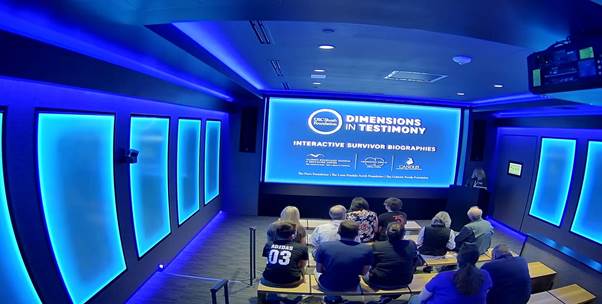We were recently asked to assist Enzo Fiondella, CEO and design engineer from Interactive Imagination, with their project at the Dallas Holocaust Museum, Texas, USA. Interactive Imagination specialise in creating leading edge immersive exhibits for museums.
The Dallas Holocaust and Human Rights Museum is dedicated to teaching the history of the Holocaust and advancing human rights to combat prejudice, hatred and indifference. A ground-breaking attraction in the museum is the Dimensions in Testimony Theatre, where visitors can interact with virtual Holocaust survivors and ask them questions about their life and survival.
Dimensions in Testimony is a collection of interactive biographies from USC Shoah Foundation that enables people to have conversations with pre-recorded video images of Holocaust survivors and other witnesses to genocide.
Creating realistic interactions with hologram of survivor
The challenge was to create a believable two-way dialogue between the audience and the survivors. High definition holograms of the survivors combined with voice recognition technology enables real time responses to be given. Using a Velodyne Puck (VLP-16) LiDAR sensor mounted on the wall, the system can perceive when and where in the theatre a visitor stands to ask a question of the survivor. It is able to recognise adults along with wheelchair users and children.
The LiDAR sensor is paired with a directional microphone ceiling array, to ensure the question is clearly received, and the on-stage holographic survivor replies once the visitor sits back down. Over 2,000 answers to questions have been recorded.
Delighted with the results
Enzo commented, “We have successfully integrated the Velodyne LiDAR sensor into our Show Control System by creating a C++ application that sends a go/ no-go signal. This categorises a person’s location in relation to a supplied grid area, it differentiates whether they are sitting or standing and has a real time processing latency of 200 milliseconds. We are delighted with the resulting effect which further enhances the live real time experience we wanted to achieve.”
The inclusion of the LiDAR sensor at Dallas is a further improvement on the first hologram installation launched by the Illinois Holocaust Museum, and has eradicated the need for a moderator to repeat the question from the audience.
LiDAR scanner in action
This video shows the system in action. It is filmed in infra-red mode so you can see the LiDAR sensor scanning the audience to locate the visitor who wishes to ask the next question. The Velodyne Puck uses Class 1 eye-safe rotating lasers and the scanning is not visible to the audience.
Gert Riemersma, CTO and founder of Mapix technologies added, “One of the advantages of working with LiDAR is being exposed to the many different and interesting new applications of this technology. Enzo and the team at Interactive Imagination have created an amazing real time experience and demonstrates how technology can be used to bring history to life and create a highly emotional response. Future generations will not forget these stories thanks to this inventive exhibition. ”
See the Velodyne Puck (VLP-16) scanner in detail
Contact us

